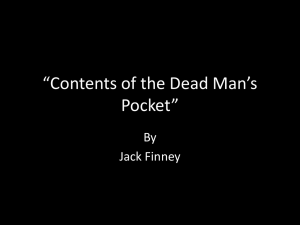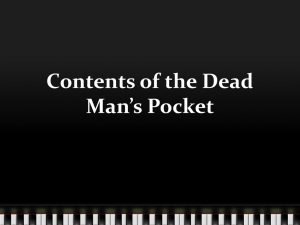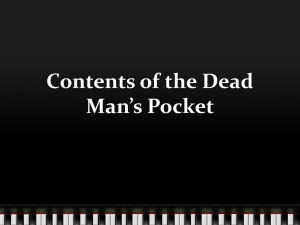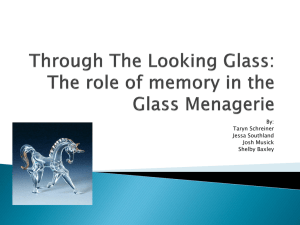HW 1
advertisement
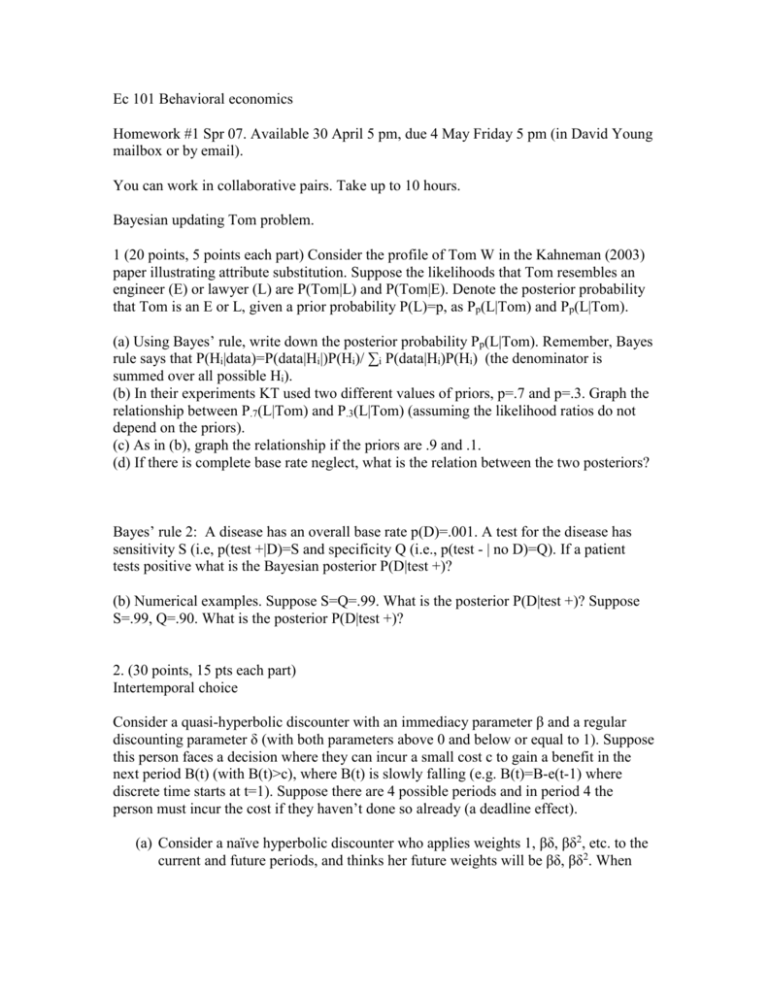
Ec 101 Behavioral economics Homework #1 Spr 07. Available 30 April 5 pm, due 4 May Friday 5 pm (in David Young mailbox or by email). You can work in collaborative pairs. Take up to 10 hours. Bayesian updating Tom problem. 1 (20 points, 5 points each part) Consider the profile of Tom W in the Kahneman (2003) paper illustrating attribute substitution. Suppose the likelihoods that Tom resembles an engineer (E) or lawyer (L) are P(Tom|L) and P(Tom|E). Denote the posterior probability that Tom is an E or L, given a prior probability P(L)=p, as Pp(L|Tom) and Pp(L|Tom). (a) Using Bayes’ rule, write down the posterior probability Pp(L|Tom). Remember, Bayes rule says that P(Hi|data)=P(data|Hi|)P(Hi)/ ∑i P(data|Hi)P(Hi) (the denominator is summed over all possible Hi). (b) In their experiments KT used two different values of priors, p=.7 and p=.3. Graph the relationship between P.7(L|Tom) and P.3(L|Tom) (assuming the likelihood ratios do not depend on the priors). (c) As in (b), graph the relationship if the priors are .9 and .1. (d) If there is complete base rate neglect, what is the relation between the two posteriors? Bayes’ rule 2: A disease has an overall base rate p(D)=.001. A test for the disease has sensitivity S (i.e, p(test +|D)=S and specificity Q (i.e., p(test - | no D)=Q). If a patient tests positive what is the Bayesian posterior P(D|test +)? (b) Numerical examples. Suppose S=Q=.99. What is the posterior P(D|test +)? Suppose S=.99, Q=.90. What is the posterior P(D|test +)? 2. (30 points, 15 pts each part) Intertemporal choice Consider a quasi-hyperbolic discounter with an immediacy parameter β and a regular discounting parameter δ (with both parameters above 0 and below or equal to 1). Suppose this person faces a decision where they can incur a small cost c to gain a benefit in the next period B(t) (with B(t)>c), where B(t) is slowly falling (e.g. B(t)=B-e(t-1) where discrete time starts at t=1). Suppose there are 4 possible periods and in period 4 the person must incur the cost if they haven’t done so already (a deadline effect). (a) Consider a naïve hyperbolic discounter who applies weights 1, βδ, βδ2, etc. to the current and future periods, and thinks her future weights will be βδ, βδ2. When will this person incur the cost? (Hint: There may be more than one answer depending on parameter values). (b) Now consider a sophisticated hyperbolic who applies the same weights but thinks her future weights will be 1, βδ, βδ2. When does this person incur the cost? 3. (20 points, 5 points each of a-c, 2.5 pts each d,e) Endowment effects: Suppose a decision-maker has preferences over amounts of pens and dollars, denoted x=(xp, xd). Decision makes care about utility from consumption and “transaction utility” which depends on the difference between their final allocations and the point of reference. Because there are two goods, the reference point also will have two dimensions, r=(rp, rd). Since the choice involves two dimensions, a simple model is to assume that the intrinsic utilities for pens and dollars can be evaluated separately and added up, so that v( xp, xd ) v( x p ) v( x d ) . Make the same assumption for the transactional components of utility, t ( x | r ) t ( y ) t ( y p ) t ( y d ) where yp=xp-rp and yd=xd-rd. For simplicity, we let the utility function for amounts be linear and let v( x p ) bx p and v( xd ) xd , so that b>0 represents the relative preference for pens over dollars. The decision maker’s utility is expressed as u ( x p , x d ; y p , y d ) bx p x d t ( y p ) t ( y d ) , where if y p 0, v( y p ) ω b y p t( y p ) v(| y p |) μ ω b y p if y p 0, 2 With μ >1 representing loss-aversion, and a parallel two-piece definition holds for t(yd) (substituting d for p). (a) (b) In a choosing condition, a person gives an amount Pc such that they are indifferent between getting $Pc and a single pen. In this case the consumer starts with nothing so assume the reference points are rp = rd =0. Solve for Pc* such that the consumer is indifferent between the money and a pen. In a buying condition, a person gives an amount Pb such that they are willing to pay up to the amount $Pb to get a single pen. In this case the consumer starts with (c) (d) (e) nothing so assume the reference points are rp = rd =0. (The difference from above is that they pay out the amount Pb rather than receive it.) Find the value Pb* which is the consumer’s maximum willingness to pay. In a selling condition, a person gives an amount Ps which is the least they would accept to sell a pen they are given to start with. In this case the consumer starts with the pen so assume the reference points are rp =1, rd =0. Find the value Ps* which is the consumer’s minimum willingness to accept (or selling price). Show the parameter values which yield an endowment effect (Ps* > Pb*). Where does the choosing value Pc* lie compared to buying and selling prices? 4. (10 points) Neuroeconomics grant proposal Choose a behavioral economics theory we have discussed so far (weeks 1-5 up through consumer choice) and speculate about what brain areas might be activated if people behave as the theory suggests. Sketch an experiment one might do to test this hypothesis. (Note: This is only 10 points because I realize for many of you, and for virtually all professional economists, this is a hard question. However, some of you have a lot of background, your collaboration should help, and your brief introduction to this field and my in-class speculations might give you some ideas. If you do some additional reading as background please note what papers you read.)

